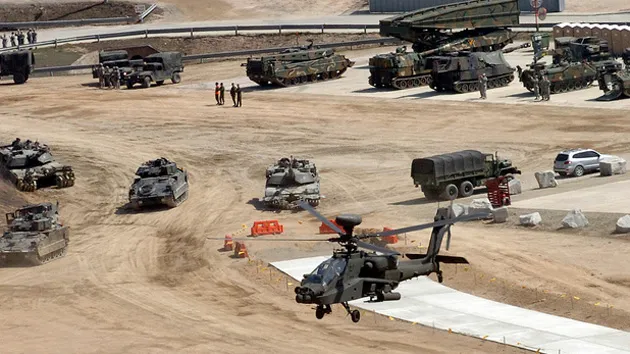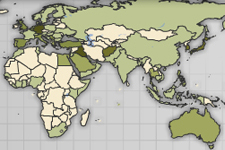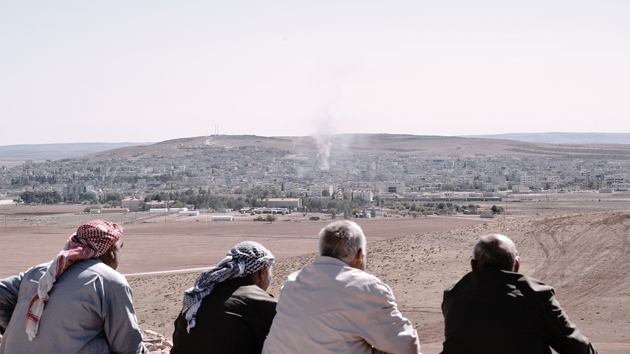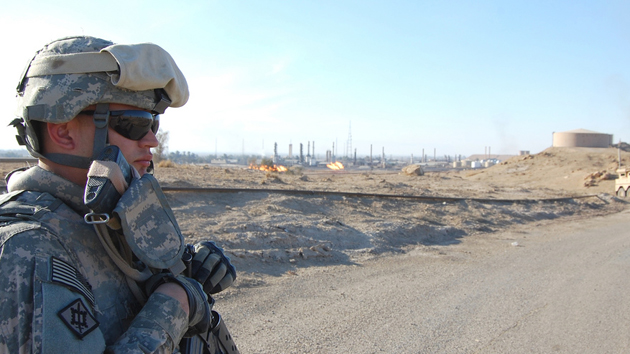
<a href="https://www.flickr.com/photos/usaghumphreys/5301757872/in/photolist-6nca2R-ck9T8Y-93WDp1-9efky1-4Akn3T-6s4Qhu-95uTUu-9jpJoU-aQNxqK-74bJAK-aPwjXF-ckeQFd-4AAtGz-5AG5ab-ckagJQ-ckeBQm-ck9UeL-aud8pj-auam3k-auds49-audoX1-aud3NU-ahZCEr-ck9HZJ-e9WkV3-auaCKk-auaxyR-ckeUHJ-7o7HqN-auduzN-auavdD-auaqo8-auaAoV-c9jiFb-8aW8Aq-5gu8sJ-aPwm3g-5nn4of-7oBDPP-aeEZH4-5LNzZD-bvFPnL-nR4Zav-8B7245-8ha2ST-ckeSQh-7X9SNy-63ZAh4-8JR26y-8xiTkQ">Geun-wook Paek</a>/Flickr
This story first appeared on the TomDispatch website.
With the launch of a new US-led war in Iraq and Syria against the Islamic State (IS), the United States has engaged in aggressive military action in at least 13 countries in the Greater Middle East since 1980. In that time, every American president has invaded, occupied, bombed, or gone to war in at least one country in the region. The total number of invasions, occupations, bombing operations, drone assassination campaigns, and cruise missile attacks easily runs into the dozens.
As in prior military operations in the Greater Middle East, US forces fighting IS have been aided by access to and the use of an unprecedented collection of military bases. They occupy a region sitting atop the world’s largest concentration of oil and natural gas reserves and has long been considered the most geopolitically important place on the planet. Indeed, since 1980, the US military has gradually garrisoned the Greater Middle East in a fashion only rivaled by the Cold War garrisoning of Western Europe or, in terms of concentration, by the bases built to wage past wars in Korea and Vietnam.
In the Persian Gulf alone, the US has major bases in every country save Iran. There is an increasingly important, increasingly large base in Djibouti, just miles across the Red Sea from the Arabian Peninsula. There are bases in Pakistan on one end of the region and in the Balkans on the other, as well as on the strategically located Indian Ocean islands of Diego Garcia and the Seychelles. In Afghanistan and Iraq, there were once as many as 800 and 505 bases, respectively. Recently, the Obama administration inked an agreement with new Afghan President Ashraf Ghani to maintain around 10,000 troops and at least nine major bases in his country beyond the official end of combat operations later this year. US forces, which never fully departed Iraq after 2011, are now returning to a growing number of bases there in ever larger numbers.
In short, there is almost no way to overemphasize how thoroughly the US military now covers the region with bases and troops. This infrastructure of war has been in place for so long and is so taken for granted that Americans rarely think about it and journalists almost never report on the subject. Members of Congress spend billions of dollars on base construction and maintenance every year in the region, but ask few questions about where the money is going, why there are so many bases, and what role they really serve. By one estimate, the United States has spent $10 trillion protecting Persian Gulf oil supplies over the past four decades.
Approaching its 35th anniversary, the strategy of maintaining such a structure of garrisons, troops, planes, and ships in the Middle East has been one of the great disasters in the history of American foreign policy. The rapid disappearance of debate about our newest, possibly illegal war should remind us of just how easy this huge infrastructure of bases has made it for anyone in the Oval Office to launch a war that seems guaranteed, like its predecessors, to set off new cycles of blowback and yet more war.
On their own, the existence of these bases has helped generate radicalism and anti-American sentiment. As was famously the case with Osama bin Laden and US troops in Saudi Arabia, bases have fueled militancy, as well as attacks on the United States and its citizens. They have cost taxpayers billions of dollars, even though they are not, in fact, necessary to ensure the free flow of oil globally. They have diverted tax dollars from the possible development of alternative energy sources and meeting other critical domestic needs. And they have supported dictators and repressive, undemocratic regimes, helping to block the spread of democracy in a region long controlled by colonial rulers and autocrats.
After 35 years of base-building in the region, it’s long past time to look carefully at the effects Washington’s garrisoning of the Greater Middle East has had on the region, the US, and the world.
“Vast Oil Reserves”
While the Middle Eastern base buildup began in earnest in 1980, Washington had long attempted to use military force to control this swath of resource-rich Eurasia and, with it, the global economy. Since World War II, as the late Chalmers Johnson, an expert on US basing strategy, explained back in 2004, “the United States has been inexorably acquiring permanent military enclaves whose sole purpose appears to be the domination of one of the most strategically important areas of the world.”
In 1945, after Germany’s defeat, the secretaries of War, State, and the Navy tellingly pushed for the completion of a partially built base in Dharan, Saudi Arabia, despite the military’s determination that it was unnecessary for the war against Japan. “Immediate construction of this [air] field,” they argued, “would be a strong showing of American interest in Saudi Arabia and thus tend to strengthen the political integrity of that country where vast oil reserves now are in American hands.”
By 1949, the Pentagon had established a small, permanent Middle East naval force (MIDEASTFOR) in Bahrain. In the early 1960s, President John F. Kennedy’s administration began the first buildup of naval forces in the Indian Ocean just off the Persian Gulf. Within a decade, the Navy had created the foundations for what would become the first major US base in the region—on the British-controlled island of Diego Garcia.
In these early Cold War years, though, Washington generally sought to increase its influence in the Middle East by backing and arming regional powers like the Kingdom of Saudi Arabia, Iran under the Shah, and Israel. However, within months of the Soviet Union’s 1979 invasion of Afghanistan and Iran’s 1979 revolution overthrowing the Shah, this relatively hands-off approach was no more.
Base Buildup
In January 1980, President Jimmy Carter announced a fateful transformation of US policy. It would become known as the Carter Doctrine. In his State of the Union address, he warned of the potential loss of a region “containing more than two-thirds of the world’s exportable oil” and “now threatened by Soviet troops” in Afghanistan who posed “a grave threat to the free movement of Middle East oil.”
Carter warned that “an attempt by any outside force to gain control of the Persian Gulf region will be regarded as an assault on the vital interests of the United States of America.” And he added pointedly, “Such an assault will be repelled by any means necessary, including military force.”
With these words, Carter launched one of the greatest base construction efforts in history. He and his successor Ronald Reagan presided over the expansion of bases in Egypt, Oman, Saudi Arabia, and other countries in the region to host a “Rapid Deployment Force,” which was to stand permanent guard over Middle Eastern petroleum supplies. The air and naval base on Diego Garcia, in particular, was expanded at a quicker rate than any base since the war in Vietnam. By 1986, more than $500 million had been invested. Before long, the total ran into the billions.
 Soon enough, that Rapid Deployment Force grew into the US Central Command, which has now overseen three wars in Iraq (1991-2003, 2003-2011, 2014-); the war in Afghanistan and Pakistan (2001-); intervention in Lebanon (1982-1984); a series of smaller-scale attacks on Libya (1981, 1986, 1989, 2011); Afghanistan (1998) and Sudan (1998); and the “tanker war” with Iran (1987-1988), which led to the accidental downing of an Iranian civilian airliner, killing 290 passengers. Meanwhile, in Afghanistan during the 1980s, the CIA helped fund and orchestrate a major covert war against the Soviet Union by backing Osama Bin Laden and other extremist mujahidin. The command has also played a role in the drone war in Yemen (2002-) and both overt and covert warfare in Somalia (1992-1994, 2001-).
Soon enough, that Rapid Deployment Force grew into the US Central Command, which has now overseen three wars in Iraq (1991-2003, 2003-2011, 2014-); the war in Afghanistan and Pakistan (2001-); intervention in Lebanon (1982-1984); a series of smaller-scale attacks on Libya (1981, 1986, 1989, 2011); Afghanistan (1998) and Sudan (1998); and the “tanker war” with Iran (1987-1988), which led to the accidental downing of an Iranian civilian airliner, killing 290 passengers. Meanwhile, in Afghanistan during the 1980s, the CIA helped fund and orchestrate a major covert war against the Soviet Union by backing Osama Bin Laden and other extremist mujahidin. The command has also played a role in the drone war in Yemen (2002-) and both overt and covert warfare in Somalia (1992-1994, 2001-).
During and after the first Gulf War of 1991, the Pentagon dramatically expanded its presence in the region. Hundreds of thousands of troops were deployed to Saudi Arabia in preparation for the war against Iraqi autocrat and former ally Saddam Hussein. In that war’s aftermath, thousands of troops and a significantly expanded base infrastructure were left in Saudi Arabia and Kuwait. Elsewhere in the Gulf, the military expanded its naval presence at a former British base in Bahrain, housing its Fifth Fleet there. Major air power installations were built in Qatar, and US operations were expanded in Kuwait, the United Arab Emirates, and Oman.
The invasion of Afghanistan in 2001 and of Iraq in 2003, and the subsequent occupations of both countries, led to a more dramatic expansion of bases in the region. By the height of the wars, there were well over 1,000 US checkpoints, outposts, and major bases in the two countries alone. The military also built new bases in Kyrgyzstan and Uzbekistan (since closed), explored the possibility of doing so in Tajikistan and Kazakhstan, and, at the very least, continues to use several Central Asian countries as logistical pipelines to supply troops in Afghanistan and orchestrate the current partial withdrawal.
While the Obama administration failed to keep 58 “enduring” bases in Iraq after the 2011 US withdrawal, it has signed an agreement with Afghanistan permitting US troops to stay in the country until 2024 and maintain access to Bagram Air Base and at least eight more major installations.
An Infrastructure for War
Even without a large permanent infrastructure of bases in Iraq, the US military has had plenty of options when it comes to waging its new war against IS. In that country alone, a significant US presence remained after the 2011 withdrawal in the form of base-like State Department installations, as well as the largest embassy on the planet in Baghdad, and a large contingent of private military contractors. Since the start of the new war, at least 1,600 troops have returned and are operating from a Joint Operations Center in Baghdad and a base in Iraqi Kurdistan’s capital, Erbil. Last week, the White House announced that it would request $5.6 billion from Congress to send an additional 1,500 advisers and other personnel to at least two new bases in Baghdad and Anbar Province. Special operations and other forces are almost certainly operating from yet more undisclosed locations.
At least as important are major installations like the Combined Air Operations Center at Qatar’s al-Udeid Air Base. Before 2003, the Central Command’s air operations center for the entire Middle East was in Saudi Arabia. That year, the Pentagon moved the center to Qatar and officially withdrew combat forces from Saudi Arabia. That was in response to the 1996 bombing of the military’s Khobar Towers complex in the kingdom, other al-Qaeda attacks in the region, and mounting anger exploited by al-Qaeda over the presence of non-Muslim troops in the Muslim holy land. Al-Udeid now hosts a 15,000-foot runway, large munitions stocks, and around 9,000 troops and contractors who are coordinating much of the new war in Iraq and Syria.
Kuwait has been an equally important hub for Washington’s operations since US troops occupied the country during the first Gulf War. Kuwait served as the main staging area and logistical center for ground troops in the 2003 invasion and occupation of Iraq. There are still an estimated 15,000 troops in Kuwait, and the US military is reportedly bombing Islamic State positions using aircraft from Kuwait’s Ali al-Salem Air Base.
As a transparently promotional article in the Washington Post confirmed this week, al-Dhafra Air Base in the United Arab Emirates has launched more attack aircraft in the present bombing campaign than any other base in the region. That country hosts about 3,500 troops at al-Dhafra alone, as well as the Navy’s busiest overseas port. B-1, B-2, and B-52 long-range bombers stationed on Diego Garcia helped launch both Gulf Wars and the war in Afghanistan. That island base is likely playing a role in the new war as well. Near the Iraqi border, around 1,000 US troops and F-16 fighter jets are operating from at least one Jordanian base. According to the Pentagon’s latest count, the US military has 17 bases in Turkey. While the Turkish government has placed restrictions on their use, at the very least some are being used to launch surveillance drones over Syria and Iraq. Up to seven bases in Oman may also be in use.
Bahrain is now the headquarters for the Navy’s entire Middle Eastern operations, including the Fifth Fleet, generally assigned to ensure the free flow of oil and other resources though the Persian Gulf and surrounding waterways. There is always at least one aircraft carrier strike group—effectively, a massive floating base—in the Persian Gulf. At the moment, the USS. Carl Vinson is stationed there, a critical launch pad for the air campaign against the Islamic State. Other naval vessels operating in the Gulf and the Red Sea have launched cruise missiles into Iraq and Syria. The Navy even has access to an “afloat forward-staging base” that serves as a “lilypad” base for helicopters and patrol craft in the region.
In Israel, there are as many as six secret US bases that can be used to preposition weaponry and equipment for quick use anywhere in the area. There’s also a “de facto US base” for the Navy’s Mediterranean fleet. And it’s suspected that there are two other secretive sites in use as well. In Egypt, US troops have maintained at least two installations and occupied at least two bases on the Sinai Peninsula since 1982 as part of a Camp David Accords peacekeeping operation.
Elsewhere in the region, the military has established a collection of at least five drone bases in Pakistan; expanded a critical base in Djibouti at the strategic chokepoint between the Suez Canal and the Indian Ocean; created or gained access to bases in Ethiopia, Kenya, and the Seychelles; and set up new bases in Bulgaria and Romania to go with a Clinton administration-era base in Kosovo along the western edge of the gas-rich Black Sea.
Even in Saudi Arabia, despite the public withdrawal, a small US military contingent has remained to train Saudi personnel and keep bases “warm” as potential backups for unexpected conflagrations in the region or, assumedly, in the kingdom itself. In recent years, the military has even established a secret drone base in the country, despite the blowback Washington has experienced from its previous Saudi basing ventures.
Dictators, Death, and Disaster
The ongoing US presence in Saudi Arabia, however modest, should remind us of the dangers of maintaining bases in the region. The garrisoning of the Muslim holy land was a major recruiting tool for al-Qaeda and part of Osama bin Laden’s professed motivation for the 9/11 attacks. (He called the presence of US troops, “the greatest of these aggressions incurred by the Muslims since the death of the prophet.”) Indeed, US bases and troops in the Middle East have been a “major catalyst for anti-Americanism and radicalization” since a suicide bombing killed 241 marines in Lebanon in 1983. Other attacks have come in Saudi Arabia in 1996, Yemen in 2000 against the USS. Cole, and during the wars in Afghanistan and Iraq. Research has shown a strong correlation between a US basing presence and al-Qaeda recruitment.
Part of the anti-American anger has stemmed from the support US bases offer to repressive, undemocratic regimes. Few of the countries in the Greater Middle East are fully democratic, and some are among the world’s worst human rights abusers. Most notably, the US government has offered only tepid criticism of the Bahraini government as it has violently cracked down on pro-democracy protestors with the help of the Saudis and the United Arab Emirates (UAE).
Beyond Bahrain, US bases are found in a string of what the Economist Democracy Index calls “authoritarian regimes,” including Afghanistan, Bahrain, Djibouti, Egypt, Ethiopia, Jordan, Kuwait, Oman, Qatar, Saudi Arabia, UAE, and Yemen. Maintaining bases in such countries props up autocrats and other repressive governments, makes the United States complicit in their crimes, and seriously undermines efforts to spread democracy and improve the wellbeing of people around the world.
Of course, using bases to launch wars and other kinds of interventions does much the same, generating anger, antagonism, and anti-American attacks. A recent U.N. report suggests that Washington’s air campaign against the Islamic State had led foreign militants to join the movement on “an unprecedented scale.”
And so the cycle of warfare that started in 1980 is likely to continue. “Even if US and allied forces succeed in routing this militant group,” retired Army colonel and political scientist Andrew Bacevich writes of the Islamic State, “there is little reason to expect” a positive outcome in the region. As Bin Laden and the Afghan mujahidin morphed into al-Qaeda and the Taliban and as former Iraqi Baathists and al-Qaeda followers in Iraq morphed into IS, “there is,” as Bacevich says, “always another Islamic State waiting in the wings.”
The Carter Doctrine’s bases and military buildup strategy and its belief that “the skillful application of US military might” can secure oil supplies and solve the region’s problems was, he adds, “flawed from the outset.” Rather than providing security, the infrastructure of bases in the Greater Middle East has made it ever easier to go to war far from home. It has enabled wars of choice and an interventionist foreign policy that has resulted in repeated disasters for the region, the United States, and the world. Since 2001 alone, US-led wars in Afghanistan, Pakistan, Iraq, and Yemen have minimally caused hundreds of thousands of deaths and possibly more than one million deaths in Iraq alone.
The sad irony is that any legitimate desire to maintain the free flow of regional oil to the global economy could be sustained through other far less expensive and deadly means. Maintaining scores of bases costing billions of dollars a year is unnecessary to protect oil supplies and ensure regional peace—especially in an era in which the United States gets only around 10% of its net oil and natural gas from the region. In addition to the direct damage our military spending has caused, it has diverted money and attention from developing the kinds of alternative energy sources that could free the United States and the world from a dependence on Middle Eastern oil—and from the cycle of war that our military bases have fed.
David Vine, a TomDispatch regular, is associate professor of anthropology at American University in Washington, D.C. He is the author of Island of Shame: The Secret History of the US Military Base on Diego Garcia. He has written for the New York Times, the Washington Post, the Guardian, and Mother Jones, among other publications. His new book, Base Nation: How US Military Bases Abroad Harm America and the World, will appear in 2015 as part of the American Empire Project (Metropolitan Books). To stay on top of important articles like these, sign up to receive the latest updates from TomDispatch.com here.
















